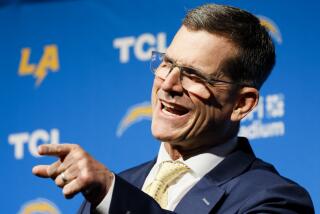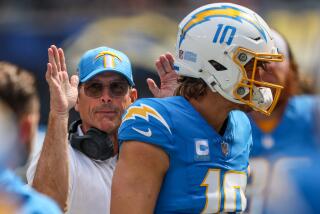THE YEAR IN REVIEW : A Look Ahead, Behind : Many Struggled Through ‘88, but Near Year Offers Hope : CHARGERS
With apologies to David Letterman, we offer lists detailing what happened in 1988 and, in some cases, how 1988 will impact 1989 .
Five reasons why the Chargers can’t possibly be as bad in 1989 as they were in 1988:
1. Al Saunders is gone.
Saunders was a good coach, a smart football man, a hard-worker, a sometimes-brilliant motivator and, in short, a perfect candidate for the vacant head-coaching job at Stanford.
But he was not the right man at the right time for kind of program Steve Ortmayer, the team’s director of football operations, was trying to put together.
The atmosphere around the Chargers’ San Diego Jack Murphy Stadium offices has been one of king-sized relief since Saunders’ dismissal. It’s as if a giant boil has been lanced. The pressure of the strain between Ortmayer and Saunders filtered down to all departments and took its toll.
2. Their schedule.
Denver, the Raiders, Kansas City and, to a lesser extent, Seattle are all teams that showed no reason in 1988 why they will be better in 1989. Those are the AFC West teams the Chargers will play twice next season. The Chargers (6-10 in 1988) also get shots at Pittsburgh, the Jets, New England, and Indianapolis. Only Houston and Philadelphia, among the Chargers’ non-division 1989 opponents, made the playoffs this season and both of those games will be in San Diego.
3. The offensive line.
It will be better next year even if injured players Gary Kowalski and John Clay don’t make it back. By the end of the year the Charger offensive line of Ken Dalliafor, Broderick Thompson, Dan Rosado, Dennis McKnight and David Richards were proud of the “Dirtbags” nickname offensive coordinator Jerry Rhome had hung on them. Fact is, running back Gary Anderson couldn’t have finished third in AFC rushing without them.
4. Mark Malone.
If the Chargers are content with him as a starter, he will fool most of his critics with his improvement in 1989 and perhaps even make people begin to forget Dan Fouts. If they bring someone else in to replace Malone, he will take his backup status like a man.
5. Probability.
Perhaps the most damning number of the year for the Charger offense was the “2” that came after the category: “Number Of Touchdown Passes At Home.”
The chances of that happening again are as unlikely as the chances of a repeat of the injury plague that ruined the seasons of so many key players.
Kowalski was to be the starting left tackle until a neck injury ended his year. Clay was to replace him until a neck injury ended his year. Linebacker Billy Ray Smith was to vie for a Pro Bowl slot until various leg injuries diminished his year. Linebacker Chuck Faucette was the team’s leading tackler until a neck injury forced him onto injured reserve. Quarterback Mark Vlasic was 2-0 as a starter until a knee injury ended his season. H-back Rod Bernstine had just begun burgeoning before a knee injury ended his season.
If drugs can be considered an injury, then that’s what kept linebacker Chip Banks from being a player the Chargers could hope to count on in 1988. Banks, a free agent holdout, was arrested in Atlanta more than once on charges of possession of illegal drugs.
Other players who missed at least one game because of injury included: kicker Vince Abbott, running back Curtis Adams, Anderson, Babe Laufenberg, Tyrone Keys and Leslie O’Neal.
And the reason tight end Kellen Winslow had to retire was the deterioration of his surgically repaired knees.
Isn’t something like this supposed to happen only every 17 years?


